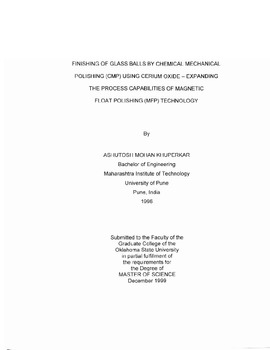| dc.description.abstract | Finishing of brittle materials requires the use of "gentle" conditions that result in minimal or no surface and subsurface damage. Conventional polishing processes make use of diamond and other hard abrasive materials, which leads to scratching and brittle fracture on the surface. While some scratches can be extremely fine, others can produce micro-cracks that could further lead to catastrophic failure of the brittle work material. This is so especially in the case of the glass finishing process where the parameters used (abrasive, polishing load, etc.) should be gentle enough to avoid brittle fracture of the surface. Magnetic Float Polishing (MFP) technology is most suitable for finishing hard and brittle materials, like ceramics and glasses. It is a "gentle" finishing process that offers flexibility and a wide range of process capabilities. This investigation stresses an extension of this technology to finish glass spheres. Due to its excellent optical properties, finished sections of glass balls are widely used in optical and medical instruments, lenses, laser and fiber optics. Glass can achieve an excellent surface finish and is also chemically resistant to a variety of materials. The finished surface of glass can provide a good seal and, hence, glass balls find wide applications in valves, pumps, flow meters, liquid dispensers, and also in special ball bearings. It is through technological advancements in chemical mechanical polishing (CMP) that the achievable level of surface finish and other parameters, such as form and sphericity, can be improved significantly. in this investigation, a methodology for finishing glass balls, MFP, with a high level of surface finish is developed. The Taguchi technique is used to determine the optimum polishing conditions for best finish and to analyze the influence of individual parameters and their levels on the polishing process. Three distinct stages in the polishing process are identified as: the first stage with emphasis on material removal rate but low surface and subsurface damage, the second semi-finishing stage with reasonable material removal rates with control over size and sphericity with again minimal or no surface damage, and the third stage of final finishing involving CMP using softer (relative to hardness of glass) cerium oxide abrasive. The use of polishing pad (lap) is introduced into the MFP system that will improve the surface finish of the glass bal'ls significantly. Surface finish - average roughness, Ra, of 10 nm (= 100 Au as measured by Talysurf characterization length of 1.5 mm) or 4.3 nm Ra (= 43 AD as measured by AFM) can be obtained using a chemically resistant synthetic polishing pad with proper combination of other process parameters derived from the Taguchi experimental design. | |
